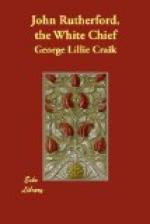“The slaves, therefore, having dug a grave for him, he was interred after my directions.
“As for the corpse of the old woman, it was now wrapt up in several mats, and carried away by Aimy and the doctor, no person being allowed to follow them. I learned, however, that they took her into a neighbouring wood, and there buried her. After this, the strangers all left our village, and returned to their respective homes. In about three months, the body of the woman was again taken up, and carried to the river side, where the bones were scraped and washed, and then inclosed in a box, which had been prepared for that purpose.
“The box was afterwards fastened on the top of a post, in the place where the body first lay in state; and a space of about thirty feet in circumference being railed in around it, a wooden image was erected, to signify that the ground was ‘tabooed,’ or sacred, and as a warning that no one should enter the inclosure. This is the regular manner of interment in New Zealand for any one belonging to a chief’s family. When a slave dies, a hole is dug, and the body is thrown into it without any ceremony; nor is it ever disinterred again, or any further notice taken of it. They never eat any person who dies of disease, or in the course of nature.”
Thus left alone among these savages, and taught by the murder of his comrade on how slight a tenure he held his own life, exposed as he was every moment to the chance of in some way or other provoking their capricious cruelty, Rutherford, it may be thought, must have felt his protracted detention growing every day more insupportable.
One of the greatest inconveniences which he now began to feel arose from the wearing out of his clothes, which he patched and tacked as well as he could for some time, but at last, after he had been about three years in the country, they would hold together no longer. All that he had to wear, therefore, was a white flax mat, which was given to him by the chief, and which, being thrown over his shoulders, came as low as his knees. This, he says, was his only garment, and he was compelled to go both bareheaded and barefooted, having neither hat, shoes, nor stockings.
His life, meanwhile, seems to have been varied by few incidents deserving of being recorded, and we are left to suppose that he spent his time principally in shooting and fishing, as before.
For the first sixteen months of his residence at the village, he kept a reckoning of days by notches on a stick; but when he afterwards moved about with the chiefs, he neglected this mode of tracing the progress of time.
[Illustration: Flute, made from the arm or thigh-bone of an enemy.]
“At last, it happened one day,” the narrative proceeds, “while we were all assembled at a feast in our village, that Aimy called me to him, in the presence of several more chiefs, and, having told them of my activity in shooting and fishing, concluded by saying that he wished to make me a chief, if I would give my consent.




